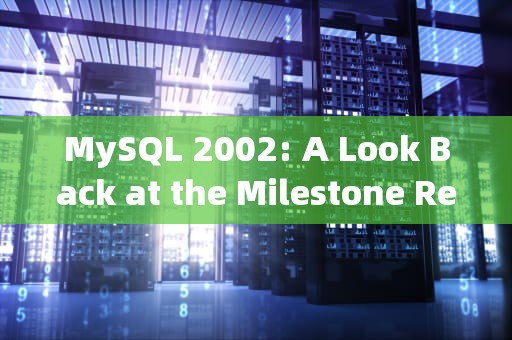In the annals of database management systems, few releases have been as influential and groundbreaking as MySQL 2002. Released on August 15, 2002, this version marked a significant milestone for MySQL, setting the stage for its future growth and solidifying its position as a leading open-source relational database management system. This article delves into the key features, improvements, and impact of MySQL 2002, highlighting why it remains a noteworthy release in the history of database technology.

The Genesis of MySQL 2002
Before we delve into the specifics of MySQL 2002, it's essential to understand the context in which it was released. Founded in 1995 by Michael Widenius, MySQL quickly gained popularity due to its speed, reliability, and cost-effectiveness. By 2002, MySQL had already established itself as a robust alternative to proprietary database systems like Oracle and Microsoft SQL Server. However, the market was evolving, and there was a pressing need for enhanced functionality and performance optimizations.
MySQL 2002 addressed these needs comprehensively, introducing several new features that significantly improved the platform's capabilities. Let's explore some of the most notable additions and enhancements.
Key Features and Enhancements
1、ACID Compliance: One of the most critical advancements in MySQL 2002 was the improvement in ACID (Atomicity, Consistency, Isolation, Durability) compliance. This ensured that transactions were processed reliably, making MySQL suitable for more complex and mission-critical applications.
2、Improved Query Performance: Query performance saw substantial enhancements with the introduction of query cache improvements and better indexing mechanisms. These optimizations made MySQL more efficient at handling large datasets and complex queries, further cementing its reputation as a high-performance database system.
3、Support for Foreign Keys: MySQL 2002 introduced InnoDB as the default storage engine, which included support for foreign keys. This feature was crucial for maintaining referential integrity across tables, a necessity for relational databases used in enterprise environments.
4、Enhanced Security Features: Security was a significant focus in this release. MySQL 2002 introduced more robust authentication methods and encryption options, providing better protection against unauthorized access and data breaches.
5、Stored Procedures and Functions: The inclusion of stored procedures and functions allowed developers to write more complex and reusable code within the database. This feature greatly improved the efficiency and maintainability of database-driven applications.
6、Triggers: MySQL 2002 also introduced triggers, enabling automated actions to be taken before or after specific events such as inserts, updates, or deletes. This added a layer of automation and complexity management to database operations.
7、Transactional Support: With InnoDB as the default engine, transactional support became more robust. This meant that developers could perform multiple operations within a single transaction, ensuring data consistency and reliability even in the event of system failures.
8、Partitioning: Partitioning support was introduced, allowing larger tables to be split into more manageable and faster-accessible segments. This feature was particularly beneficial for handling big data and improving query performance on massive datasets.
9、Replication Enhancements: Replication capabilities were significantly enhanced, making it easier to set up master-slave replication configurations. This was crucial for load balancing, failover, and high availability setups.
10、Backup and Recovery Tools: MySQL 2002 came with improved tools for backup and recovery, ensuring that data could be securely saved and restored with minimal downtime.
Impact and Legacy
The release of MySQL 2002 had a profound impact on the database community and the broader tech industry. Here are some ways in which this release shaped the future of MySQL and relational databases:
1、Enterprise Adoption: The enhanced features and improved performance made MySQL more attractive to enterprises. Companies began to adopt MySQL for mission-critical applications, knowing they could rely on its stability and scalability.
2、Open Source Leadership: MySQL 2002 reinforced MySQL's position as a leader in the open-source database space. Its success demonstrated that open-source solutions could compete with and often surpass proprietary alternatives in terms of performance and features.
3、Community Growth: The release spurred significant growth in the MySQL community. More developers and organizations contributed to the project, leading to a richer ecosystem of tools, extensions, and best practices.
4、Innovation Catalyst: Many of the features introduced in MySQL 2002 set the stage for future innovations. For example, the emphasis on ACID compliance and transactional support paved the way for more advanced features in subsequent releases.
5、Educational Resources: The improvements and new features in MySQL 2002 led to an increase in educational resources, tutorials, and documentation, making it easier for newcomers to learn and master MySQL.
Challenges and Criticisms
Despite its many successes, MySQL 2002 was not without its challenges and criticisms. Some users found the transition to InnoDB as the default storage engine to be challenging, especially those who were accustomed to MyISAM. Additionally, there were concerns about the initial performance overhead introduced by certain new features, although these were often mitigated through subsequent optimizations and updates.
Conclusion
MySQL 2002 stands as a testament to the power of continuous innovation and community-driven development. Its release marked a significant leap forward in terms of functionality, performance, and reliability, setting a high bar for future versions of MySQL. As we look back on this milestone release, it's clear that MySQL 2002 played a crucial role in shaping the landscape of modern database management systems, influencing both open-source and commercial platforms alike.
The legacy of MySQL 2002 continues to be felt today, as many of the features and improvements introduced in this release remain integral parts of the MySQL ecosystem. As technology evolves, MySQL's commitment to innovation, as exemplified by this release, ensures that it will continue to be a dominant force in the world of database management.
随着互联网的普及和信息技术的飞速发展台湾vps云服务器邮件,电子邮件已经成为企业和个人日常沟通的重要工具。然而,传统的邮件服务在安全性、稳定性和可扩展性方面存在一定的局限性。为台湾vps云服务器邮件了满足用户对高效、安全、稳定的邮件服务的需求,台湾VPS云服务器邮件服务应运而生。本文将对台湾VPS云服务器邮件服务进行详细介绍,分析其优势和应用案例,并为用户提供如何选择合适的台湾VPS云服务器邮件服务的参考建议。

工作时间:8:00-18:00
电子邮件
1968656499@qq.com
扫码二维码
获取最新动态
